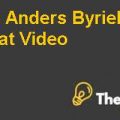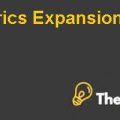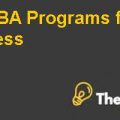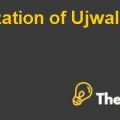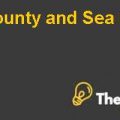
Price/Earning Model:
Price/Earnings ratios are another model, which are used to calculate the cost of capital. It is an equity multiple which calculates the cost of equity through earnings per share. The formula for P/E model is given below:
In this above formula, Re(L) is representing the cost of equity which resulted from the followings:
b= Retention ratio or (1-Payout Ratio)
g=growth rate
P/E= Price Earning
To incorporate this formula into the given case; the following values are analyzed in this formula:
Payout ratio was 60% with growth rate of 4% and with a different P/E according to the data for the particular years, which resulted in cost of equity. These costs of equities are given in the table below:
|
Star Appliances Cost of Equity using Price/Earning Model |
|||||||||
|
1979 |
1980 |
1981 |
1982 |
1983 |
1984 |
||||
|
10.81% |
9.70% |
9.60% |
8.21% |
8.45% |
8.48% |
||||
Capital Assets Pricing Model:
The formula for capital assets pricing model is given below:
Er=Expected Return
Rfr= Risk free return on treasury bonds
Rm= Market risk premium or Market return
B= Beta
Capital asset pricing model is used to calculate the required rate of return by taking risk and return into account. In this model, risk is defined by the symbol b known as Beta. It also incorporates return on risk free assets and market expected return. From the case analysis market return is 11.7%, risk free rate on treasury bills is 3.4% with the market premium of 8.3% and beta in this model is 0.95. Through calculation given in the excel sheet, cost of capital is 10.87%. This cost of capital is incorporated to form the cost of debt which is 12.79% and cost of equity which is 11.29%. Star Appliances is considering raising the cost of debt to industry average which is 19%. Through this increased cost of debt, cost of capital will decrease because dividend payments are not deductable as compared to the cost of debt. Please refer the excel sheet for WACC calculations.
|
Star Appliances Cost of Equity using Capital Assets Pricing Model |
|||||||||
|
1979 |
1980 |
1981 |
1982 |
1983 |
1984 |
||||
| Risk Free Rate |
3.40% |
3.40% |
3.40% |
3.40% |
3.40% |
3.40% |
|||
| Beta |
0.95 |
0.95 |
0.95 |
0.95 |
0.95 |
0.95 |
|||
| Market Return |
11.7% |
11.7% |
11.7% |
11.7% |
11.7% |
11.7% |
|||
| Cost of Equity |
11.3% |
11.3% |
11.3% |
11.3% |
11.3% |
11.3% |
|||
Internal rate of returns are also calculated for specific projects. Each project has its own internal rate of return and by using these internal rates; funds can be allocated on the basis of returns that each project generates. The internal rates of returns for each project are given in the table below:
|
Internal rate of return |
Dishwasher |
Food Waste Disposal |
Trash Compactor |
|
20.80% |
10.60% |
15.20% |
Conclusion/Recommendations
Conclusion is made by analyzing the capital assets pricing model, dividend discounted model and price/earnings model. From the internal rate of return, it is concluded that Star Appliances should continue all three projects as their internal rate of returns are above industry averages and their internal rate of returns are greater than the weighted average cost of capital.................................
This is just a sample partial case solution. Please place the order on the website to order your own originally done case solution.

